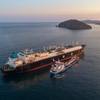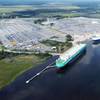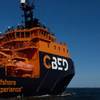LNG Bunkering Market to Reach $12bn by 2024
The global LNG bunkering market was valued at approximately USD 397.70 million in 2017 and is expected to generate revenue of around USD 11899.60 million by the end of 2024, growing at a CAGR of around 59.4% between 2018 and 2024.
LNG bunkering is experiencing the highest growth rate in developed as well as developing countries, said a report by Zion Market Research.
Escalating number of vessels using LNG owing to the need for cleaner fuels in compliance with the stringent government regulations in order to reduce air pollution and maintain sustainability is the main driver that is boosting the growth of the market. This particular factor is driving the development of the LNG bunkering market.
The regulatory organization the International Maritime Organization (IMO) in 2012, expressed that boats must reduce their sulfur content in fuel from 4.5% to 3.5 Different end-users are substituting and replacing the conventional and traditional fuels because of the cost effectiveness, for example, natural gas with LNG, given its noteworthy cost advantage over the previous.
LNG generally has lower volume than traditional flammable gases, and because of this attribute, it makes LNG safe and easier to transport. This has prompted widespread usage of LNG across different enterprises thus making it extremely favorable for the market to grow.
Moreover, formulating rules and standards are driving structural growth in the development of LNG as a shipping fuel. These regulations are implemented through the IMO's for the prevention of pollution from ships, yachts, and boats.
Although these motors have their own prerequisites and fuel requirements, certain regions have likewise been assigned with stricter emission limits. Other than air quality measure, the IMO is additionally introducing devices to monitor, screen, and substantially reduce GHG (Greenhouse Gas) emissions from ships.
Based on vessel, the LNG bunkering market is segmented into container ships, tankers, ferries & offshore support vessels, and bulk & general cargo vessels. On the basis of product type, the market is segmented into port-to-ship, portable tanks, ship-to-ship, and truck-to-ship.
Europe held substantial revenue share of the global LNG bunkering market in 2017 and the region is anticipated to continue with its regional supremacy over the forecast time period. The growth of this regional market is attributed because Norway region in Europe is considered to be the biggest bunking center, as it offers more than 18,000 LNG bunk stations
Asia Pacific region is predicted to provide significant opportunities for LNG bunkering. The region is a manufacturing hub. Because of this, the manufacturing and production activities in this region have a demand for energy.
Some of the industry players operating in the LNG bunkering market include Skangas, Korea Gas Corporation, Harvey Gulf International Marine LLC, Fjord Line, Polskie LNG, Royal Dutch Shell Plc., ENN Energy, Prima LNG, Bomin Linde LNG GmbH & Co KG, and Crowley Maritime Corporation, among others.










